CMU Mathematics Undergraduate Research, 2021
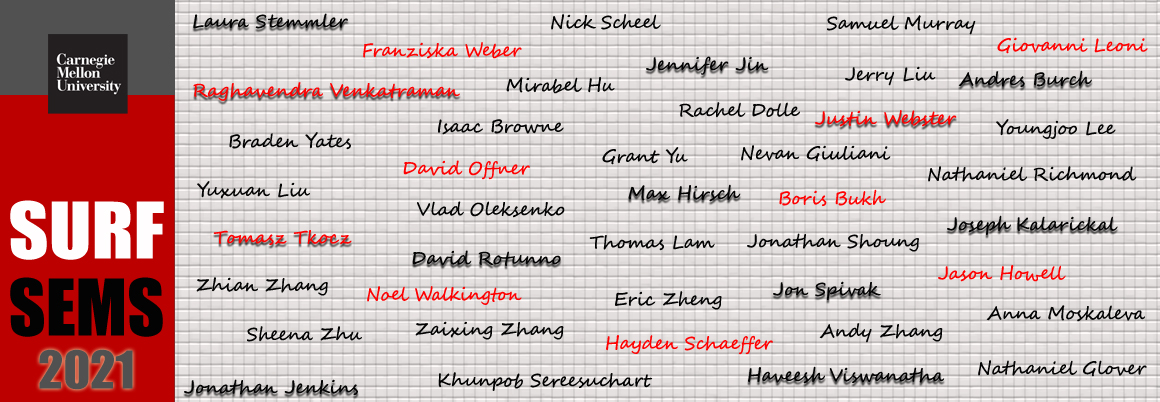
In early 2020, as the global coronavirus pandemic brought the world to a screeching halt, many of our students found that their summer programs had been cancelled. Many of these students were very interested in using this suddenly free summer to engage with open ended-projects in mathematics. In response to this demand, the Department of Mathematical Sciences curated a brand new summer program: Summer Experiences in Mathematical Sciences (SEMS). This program is offered in parallel with the traditional SURF program, which provides stipends to students who stay at CMU in the summer months to work on research projects. Find below details of the projects conducted in the summer of 2021 under the auspices of the SURF and SEMS program.
▼ SURF projects
► Improving the Gaussian Correlation Inequality
Isaac Browne
Advisor: Tomasz Tkocz
Abstract: The Gaussian Correlation Inequality is the statement that the standard Gaussian measure of the intersection of two convex symmetric sets is at least the product of their measures. This project is devoted to extending and improving this inequality. In particular, we show several cases of a conjectured strengthening involving a Minkowski sum, with the unconditional case extending to product measures with arbitrary nonincreasing densities. In addition, we provide a counterexample to another correlation inequality for complements of symmetric strips.
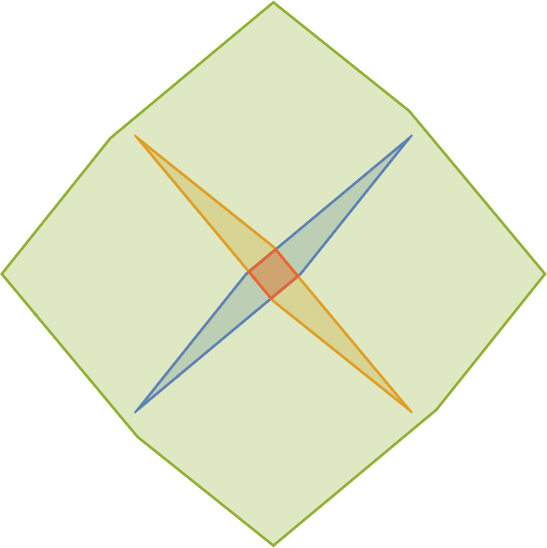
► Flutter in Clamped-Free Bridge Dynamics
Rachel Dolle and Anna Moskaleva
Advisors: Jason Howell and Justin Webster (UMBC)
Abstract: In this research we develop codes to construct computational simulations of the dynamics of a structure immersed in a surrounding flow field. The dynamics of the structure are modeled by a nonlinear fourth-order partial differential equation (PDE) with implicit damping terms and a piston-theoretic term representing the fluid-structure interaction. The configuration of interest is that of a long, slender beam that is clamped on two opposing ends and is free on the other two ends, modeling the behavior of a suspension bridge. The project resulted in both finite difference codes and spectral method codes to simulate the dynamics of the bridge.
The purpose of the project is then to study the dynamics of the bridge configuration under certain conditions.
The primary goal is to use the codes to determine the structural and flow field parameters that lead to the onset of flutter, i.e. instabilities in the oscillatory motion of the structure, that could lead to rupture, such as with the Tacoma Narrows Bridge collapse in 1940.
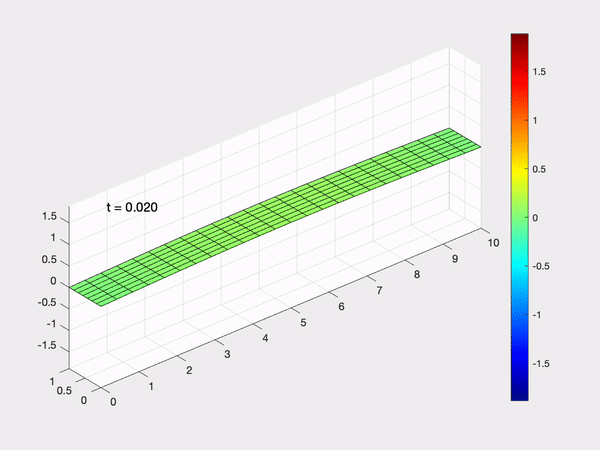
► Modeling Thermodynamic Properties in Mixtures
Nevan Giuliani
Advisor: Noel Walkington
Abstract: In this project, I will create a library that allows for the computation of physical properties of greenhouse gases in various states of matter. The physical properties that I will be focused on such as free energy and entropy usually do not have a closed form function that computes their values.
The computation of these quantities is required by climate change models to determine the distribution of greenhouse gases into the various states of matter at particular conditions. The functions we will devise must be consistent with certain properties guaranteed by physics. Thus, the functions must be increasing in certain inputs, convex/concave in certain inputs, and homogeneous. Using these restrictions, along with experimental data, I will develop methods for computing these quantities at a given condition. I will then program the functions so that climate change software can call them. Lastly, I will test the functions against measured data to evaluate performance and make adjustments as needed.
► Numerical Methods for Approximating Liquid Crystal Dynamics
Nathaniel Glover, Jennifer Jin
Advisor: Franziska Weber
Abstract: In our research, we expand on the angular momentum finite difference method for computing three dimensional wave maps into spheres and modeling liquid crystals by letting the three Frank elastic constants differ from each other. Before going further, we confirmed the physical realism of the smooth model by showing that it conserves energy. The main focus of our work is the discretization of this generalized model, and we have proved that the discrete model is indeed energy conserving.
We translate our results into a simulation, complete with visualization, where we can change initial conditions, elastic constants, and boundary conditions.
► Energy-Stable Numerical Schemes for the Q-Tensor Flow of Liquid Crystals
Max Hirsch
Advisor: Franziska Weber
Abstract: Liquid crystals are a state of matter with properties intermediate to those of liquids and those of crystals. Like a crystal, liquid crystals have an orientation, and we can model how this orientation changes over time by a system of PDEs. Gudibanda, Weber, and Yue describe a convergent, fully discrete energy-stable finite difference scheme for solving this system of PDEs. We extend this work by adding a term to the PDE system which accounts for inertia, and we present two different finite difference schemes for this system and prove that they are energy-stable.
We then present a different scheme for solving this system of PDEs using the finite element method and show that this scheme obeys an energy law analogous to those obeyed by the finite difference schemes. We implement the schemes in Python.
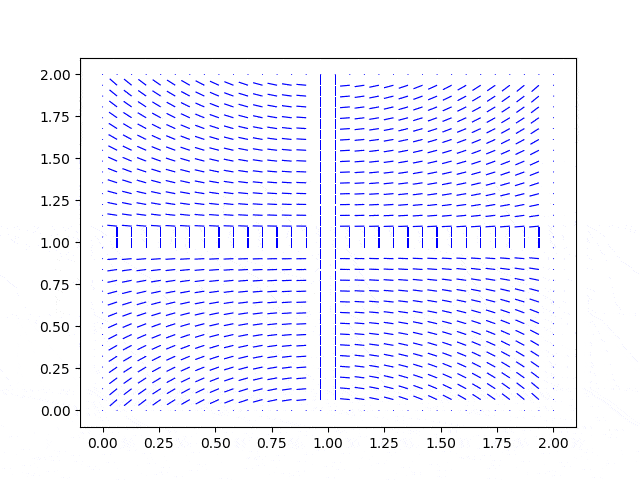
► Gamma convergence for minimization problems
Thomas Lam
Advisor: Giovanni Leoni
Abstract: A useful notion in the study of minimization problems is the gamma limit, defined for sequences of functions, because it preserves some minimizing properties. Of particular interest is the gamma limit of functionals over Sobolev spaces. In this research, we first derive compactness results for functionals such as $F_n(u) = \int_0^1\epsilon_n^{-1}(u(t)^2-1)^2 + \epsilon_nu'(t)^2\,dt$ for a sequence $\epsilon_n \to 0^+$.
Then we compute the gamma limit of the sequence of functionals under the convergence obtained from compactness. Functionals of this form are of interest because the term $(u(t)^2-1)^2$ induces a double-welled potential system. So if the potential $|F_n(u)|$ is small, then the function $u$ tends to stay close to the two ``wells" of $(z^2-1)^2$ located at $z = \pm 1$, and each "jump" from $-1$ to $1$ (or vice versa) comes at the cost of increasing the term $\int_0^1 \epsilon_nu'(t)^2\,dt$. The final goal of this project is to study more general functionals of the form $$F_n(u)=\int_0^1f_{\epsilon_n}(u(t),u’(t),u’'(t)) dt.$$
► Learning Governing Equations with Randomized Basis
Youngjoo Lee
Advisor: Hayden Schaeffer
Abstract: Our goal is to approximate the governing equations of some unknown dynamical system from data. We consider first order in time parabolic and hyperbolic PDE, whose semi-discrete approximations are (localized) ODEs. We approximate the unknown differential system using a data-driven dictionary with randomized features and train the system using the LASSO problem. As an example, notice that in the image, the simulation based on our learned governing equation (orange) is close to the true dynamics (blue) and thus we have found a good approximation to the velocity field.
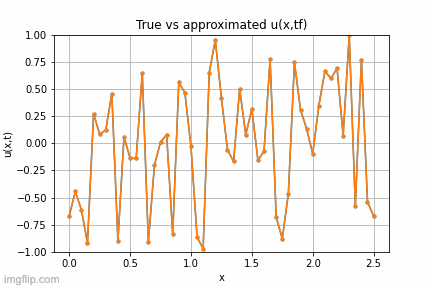
► Isoperimetric Inequalities for the Hamming Cube
Jerry Liu
Advisor: Tomasz Tkocz
Abstract: This research project is devoted to an isoperimetric inequality for the Hamming Cube. We find a general lower bound for the power-sum of numbers of boundary edges for an arbitrary subset of the Hamming Cube in terms of its measure, for product Bernoulli measures. Motivated by Talagrand’s inequality and the recent one due to Kahn and Park, we extend their results to other exponents in some cases and seek optimal values of the constants involved. Results of this type have found applications in logic, coding theory, and combinatorics.
► Random feature maps for learning agent-based models
Yuxuan Liu
Advisor: Hayden Schaeffer
Abstract: In agent-based systems, the evolution of multiple agents is determined by their relative distance and position, with magnitude given by an interacting kernel . Given observed (noisy) trajectory samples of all agents, we derived a method to recover the kernel using a new random feature method. This allows us to model smooth trajectories without knowing the exact parameterize form.
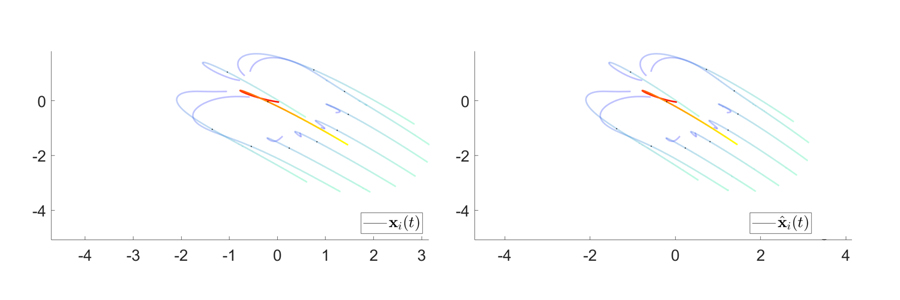
Using the learned interaction kernel, we can re-simulate the system and make predictions of the future states. The figures compare the actual trajectories (left) and our learned trajectories (right) for the Predator-Prey system.
► Regularity of solutions to the obstacle problem
Vlad Oleksenko
Advisor: Giovanni Leoni
Abstract: The obstacle problem is a classic example of a problem in the study of calculus of variations and free boundary problems. The problem consists of minimizing an energy functional over the set of functions which are constrained to certain values on the boundary of a domain, with the additional requirement that these functions lie above a certain obstacle function. Though this problem has been studied by analysts in multiple dimensions of the Euclidean space, in this research we study the one-dimension dimensional variant of this problem, which allows us to prove new results. In this project, we study the regularity of solutions to the obstacle problem, and determine its relationship to the regularity of the obstacle function. In particular, we first establish sufficient and necessary conditions on the obstacle for a solution to exist, and we also show that solutions are unique in general. Next, we are able to prove three novel results about the regularity of the solution. First, we show that all solutions are concave.
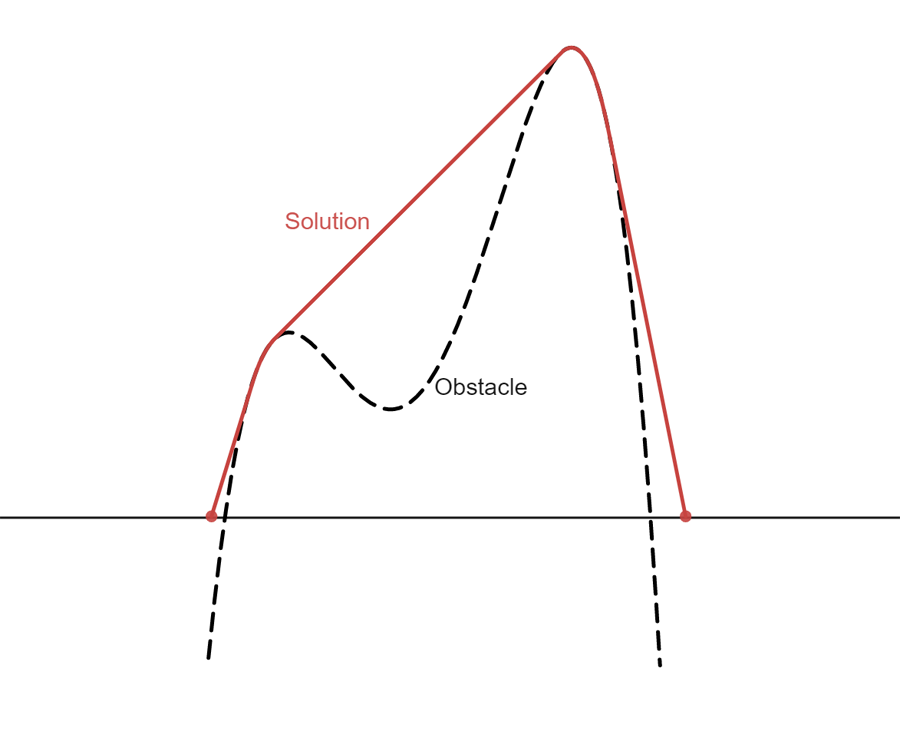
Second, we show that differentiable obstacles guarantee a solution that is continuously differentiable. Third, we prove that obstacles of class $C^{1,\alpha}$ guarantee a solution of the same class. In fact, we determine that no further restrictions on the obstacle can be placed in order to guarantee a better regularity than $C^{1,1}.$ Finally, we provide a new method for constructing the solution to the obstacle problem directly, which does not rely on minimization.
► Trace of homogeneous fractional Sobolev spaces in infinite strip domains of constant width
Khunpob Sereesuchart
Advisor: Giovanni Leoni
Abstract: In this project, we analyze the trace operator for homogeneous fractional Sobolev spaces for infinite strip domains of constant width. We look at semi-norms over the boundary where the trace is bounded, and from this we derive an inverse. The semi-norms imposed on the trace resemble those present in homogeneous Sobolev spaces, which was established by G. Leoni and I. Tice in 2019.
However, due to more global properties of fractional Sobolev spaces, we are required to impose another seminorm to regulate the trace outside of what the screened seminorm regulates. The proof techniques mainly stem from the analysis of the trace of fractional Sobolev spaces on half-spaces, relying on slicing the domain along different axes to establish bounds that are easier to work with. This result suggests that fractional Sobolev spaces on infinite strip domains of Lipschitz width will be similar to its Sobolev space counterpart, with an additional seminorm bounding distant differences.
► An Approach to the Fractional Gagliardo-Nirenberg Inequality via Algebraic Identities
Grant Yu
Advisor: Giovanni Leoni
Abstract: In this research, we discovered an elementary approach to proving various cases of the Gagliardo-Nirenberg Inequality on fractional Sobolev Spaces $W^{s,p}$ equipped with Slobodeckij seminorms. The main idea consists of using algebraic identities and basic inequalities such as Hölder and the Arithmetic Mean-Geometric Mean Inequality to prove results for most cases of the inequality, then using Hardy-Littlewood Maximal function to allow algebraic manipulations to carry over when $s$ is an integer.
▼ SEMS projects
► The subword complexity of finite binary words
Andres Burch, Joseph Kalarickal, Jonathan Shoung
Advisor: Irina Gheorghiciuc
Abstract: The subword complexity of a binary word $w$ of length $n$ is the sequence $(f(1),f(2),\ldots,f(n))$, where $f(i)$ is the number of distinct subwords of $w$ of length $i$. The problem of finding the necessary and sufficient conditions for a sequence of $n$ natural numbers to be the subword complexity sequence of a finite binary word is still open. In this paper we use several necessary conditions to find an upper bound for the number of distinct subword complexity sequences of binary words of length $n$. According to computer results the number of actual distinct subword complexity sequences of binary words of length $n$ is asymptotic to $(1.4142)^n$.
Our upper bound is asymptotic to $0.22597486(1.495)^n$, and thus very close to the suspected number of distinct subword complexity sequences of binary words of length $n$.
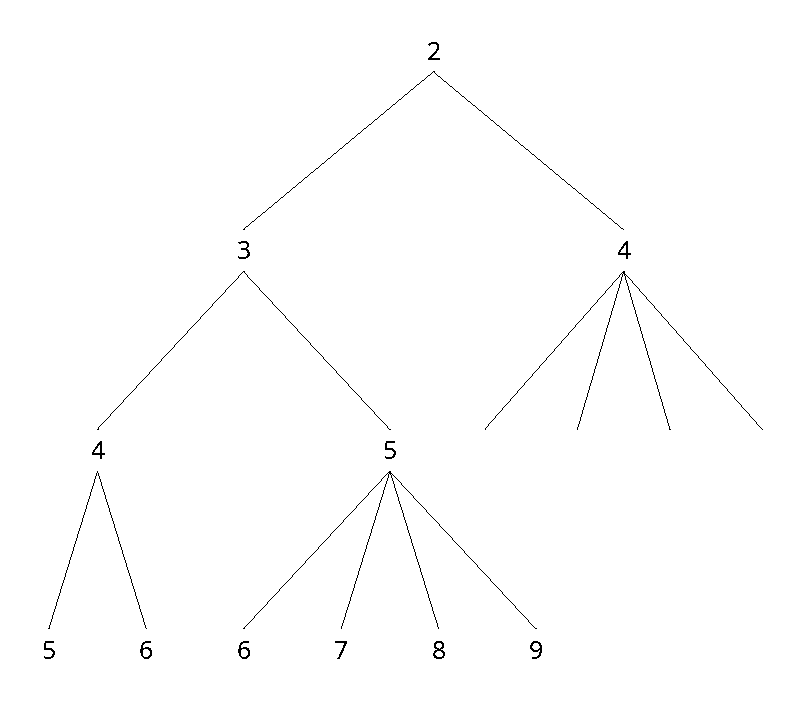
► Embedding dimensions of simplicial complexes on few vertices
Mirabel Hu, Nick Scheel
Advisor: Florian Frick and Steven Simon (Bard College)
Abstract: Planar graphs - those that can be drawn in the plane without intersecting edges - are not difficult to characterize. Simplicial complexes are generalizations of graphs that in addition to vertices and edges may also contain triangles, tetrahedra, and higher-dimensional simplices.
Here a characterization of simplicial complexes that may be realized in d-space without overlap is out of reach. We prove such a characterization for those simplicial complexes that have at most d+3 vertices. On the one hand this generalizes classical non-embeddability results. On the other hand, this result may be thought of as a topological version of the Erdös-Ko-Rado theorem in extremal combinatorics.
► Isoperimetric Inequalities
Jonathan Jenkins, David Rotunno
Advisor: Raghavendra Venkatraman
Abstract: We review relationships of the isoperimetric inequality to other classical inequalities in functional analysis, such as the Sobolev inequality and the Brunn-Minkowski inequality. We then consider the relative isoperimetric problem, which involves minimizing perimeter subject to a volume constraint among sets contained in a given domain. We study this problem in the simplified setting of polygonal sets.
► Anisotropic Variants of the Heisenberg-Pauli-Weyl inequality
Jon Spivak, Haveesh Viswanatha
Advisor: Raghavendra Venkatraman
Abstract: We review a careful analytical proof of the Heisenberg-Pauli-Weyl inequality. We then prove some anisotropic variants of it, and carefully characterize the cases of equality.
► Chirality in convex geometry
Laura Stemmler, Mirabel Hu, Nick Scheel, Samuel Murray
Advisor: Florian Frick and Steven Simon (Bard College)
Abstract: An object is chiral if it cannot be transformed into its mirror image. For example, a Möbius strip is chiral: It has a left-handed and a right-handed version. In this project we prove chiral versions of some of the main theorems of convex geometry.
These results take the following general form: Even if a collection of convex sets or of points in d-space does not meet the prerequisites of some theorem in convex geometry, the conclusion might still hold under weaker requirements at some point in time, if we transform the collection into its mirror image. For example, Radon's theorem asserts that any d+2 points in d-space may be split into two parts whose convex hulls intersect. The chiral version says that if we transform just d+1 points into their mirror image, at some time we can split them into two sets whose convex hulls intersect.
► Radon-type continuous generalizations of hyperplane mass partitions
Laura Stemmler, Samuel Murray
Advisor: Florian Frick and Steven Simon (Bard College)
Abstract: Radon-type results have the following general form: Given a point set in d-space of a certain size there are two disjoint subsets with certain properties whose convex hulls intersect. A well-studied problem asks which results of this kind have topological generalizations, where convex hulls are replaced by continuous images of simplices.
Hyperplane mass partition results are concerned with the question whether for any j measures in d-space there are k hyperplanes that cut each mass into equal-volume pieces. Hyperplane mass partition results and Radon-type results can be translated into one another through a process called Gale transformation. In this project we prove topological generalizations of the Gale transforms of all hyperplane mass partition results with one or two hyperplanes.
► The prophet problem with corrupted distributions
Braden Yates, Zhian Zhang, Sheena Zhu
Advisors: David Offner and C. J. Argue
Abstract: In the classical prophet problem, a player is given a sequence of $n$ distributions $\mathcal{D}_1, \mathcal{D}_2,\dots, \mathcal{D}_n$. After seeing all the distributions, the player sees independent random draws $X_1,X_2,\dots, X_n$ in sequence. Upon seeing $X_i$, the player must accept $X_i$ and end the game or reject $X_i$ in order to see $X_{i+1}$. The player's objective is to select an $X_i$ of maximum value. The classical performance metric is the competitive ratio, which is the ratio of the player's chosen value to the retrospective optimum value, namely the maximum $\max_i X_i$. We investigate a model of the problem with corrupted distributions. Namely, there is a fixed number $r$ (known to the player) of indices $i$ in $[n]$ for which the value $X_i$ is drawn from a distribution $\tilde{\mathcal{D}}_i$, which may be arbitrarily different from $\mathcal{D}_i$.
We give an algorithm with competitive ratio $\frac{1}{8r+4}$, and prove that no algorithm has competitive ratio greater than $\frac{1}{2r+1}$.
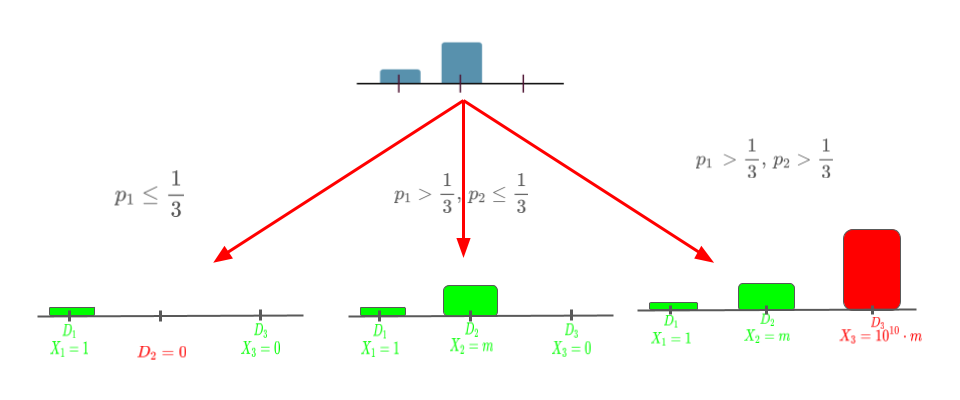
For a generalized version of the problem, where the player selects $k$ items with the objective of maximizing the sum of their values, we obtain an algorithm with competitive ratio $\frac{k}{8r+4k}$.
► Synchronization in Kuramoto Oscillators and Asymmetric Variants
Andy Zhang, Nathaniel Richmond
Advisor: Raghavendra Venkatraman
Abstract: We conduct various numerical experiments pertaining to Kuramoto oscillators. We study the role of nonreciprocal coupling between the oscillators, and numerically investigate how this, and other effects such as the natural frequencies of the oscillators affects synchronization.
► Dispersion in dimension two
Zaixing Zhang, Eric Zheng
Advisor: Boris Bukh
Abstract: Dispersion of a set $P$ is the area of the largest axis-parallel rectangle containing no point of $P$. In this project, we investigated dispersion of sets in the two-dimensional torus. We found lattices of largest dispersion and searched for lattices of small dispersion with a computer.
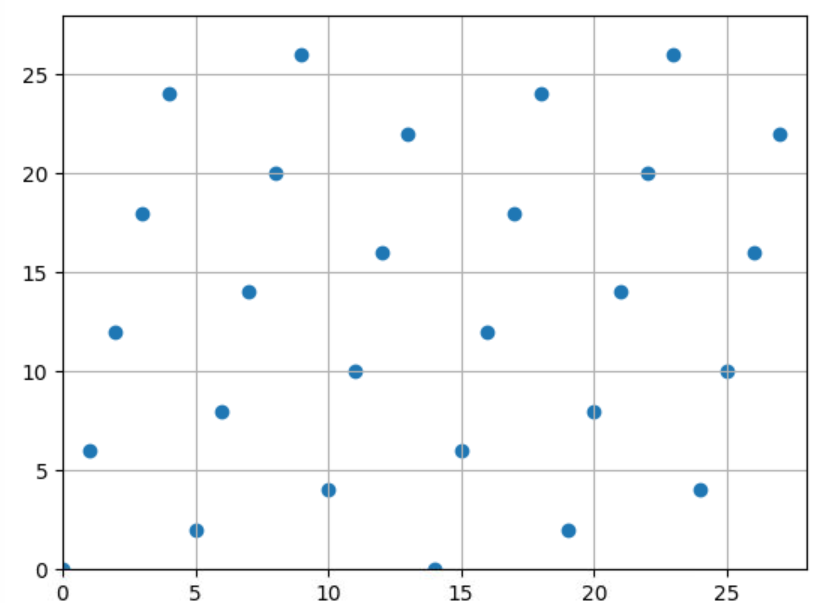
28-point lattice of smallest dispersion
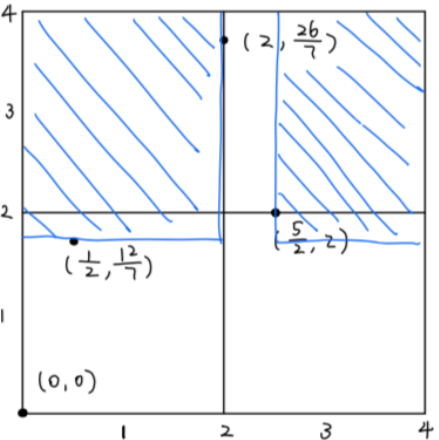
Non-lattice 4-point set of smallest dispersion, and a largest empty box therein
2021 SURF team
Students: Isaac Browne, Rachel Dolle, Nevan Giuliani, Nathaniel Glover, Max Hirsch, Jennifer Jin, Thomas Lam, Youngjoo Lee, Jerry Liu, Yuxuan Liu, Anna Moskaleva, Vlad Oleksenko, Khunpob Sereesuchart, Grant Yu
Faculty: Jason Howell, Giovanni Leoni, Hayden Schaeffer, Tomasz Tkocz, Noel Walkington, Franziska Weber, Justin Webster (UMBC)
2021 SEMS research team
Students: Andres Burch, Mirabel Hu, Jonathan Jenkins, Joseph Kalarickal, Samuel Murray, Nathaniel Richmond, David Rotunno, Nick Scheel, Jonathan Shoung, Jon Spivak, Laura Stemmler, Haveesh Viswanatha, Braden Yates, Andy Zhang, Zaixing Zhang, Zhian Zhang, Eric Zheng, Sheena Zhu
Faculty: C. J. Argue, Boris Bukh, Florian Frick, Irina Gheorghiciuc, David Offner, Steven Simon (Bard College), Raghavendra Venkatraman